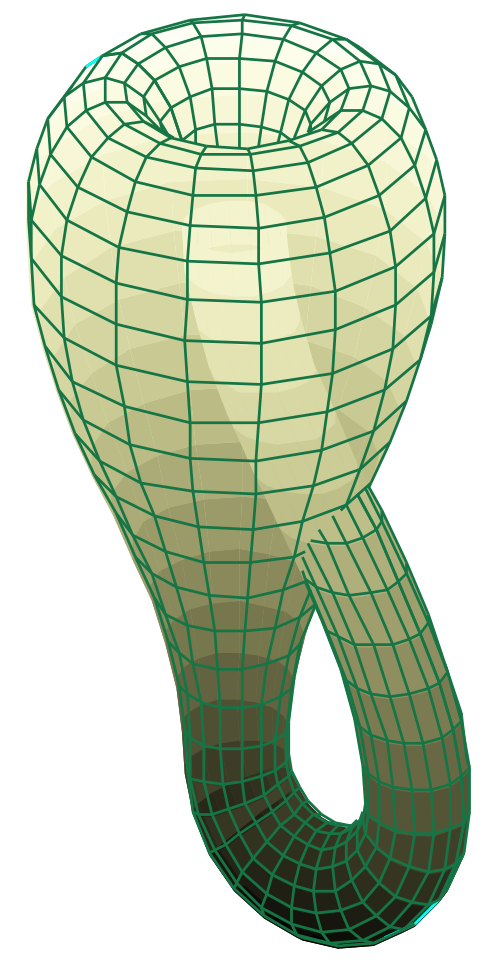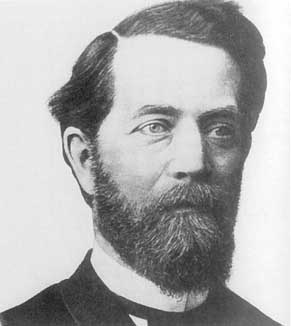
Klein Bottle by Tttrung
On April 25, 1849, German mathematician and mathematics educator Felix Klein was born. Klein is known for his work in group theory, complex analysis, non-Euclidean geometry, and on the connections between geometry and group theory. His 1872 Erlangen Program, classifying geometries by their underlying symmetry groups, was a hugely influential synthesis of much of the mathematics of the day. Klein also devised the Klein-bottle, a one-sided surface which, if traveled upon, could be followed back to the point of origin while flipping the traveler upside down.
A mathematician named Klein
Thought the Möbius band was divine.
Said he: “If you glue
The edges of two,
You’ll get a weird bottle like mine.”
(Leo Moser)
Felix Klein – Early Years
Felix Klein’s father was an old Prussian Protestant from Ennepetal in southern Westphalia. He was district administrator of the government’s main fund in Düsseldorf, while Klein’s mother came from industrial circles in Aachen. In the autumn of 1865 Felix Klein began studying mathematics and natural sciences at the University of Bonn. Klein studied in Bonn with Rudolf Lipschitz and Julius Plücker, whose assistant he became. After Plucker’s death Alfred Clebsch took over the publication of his unfinished work and transferred this work to the talented Klein. Klein received his doctorate in 1868 from Plücker with a topic from geometry applied to mechanics. In 1869 he went to Berlin University and listened to a lecture by Leopold Kronecker on square forms.[5] He took part in the mathematical seminars of Ernst Eduard Kummer and Karl Weierstrass, where he also met Sophus Lie, with whom he went to Paris for a study visit in 1870 and was a friend. Due to the Franco-German War he returned to Germany. He habilitated at Clebsch in Göttingen in 1871 and remained in Göttingen as a private lecturer in 1871/72.[6,7]

Felix Klein (1849-1925)
The Erlangen Programme
The University of Erlangen appointed Klein professor when he was only 23 years old. By that time, he was already one of the most important representatives of 19th century geometry and had worked, for example, on projective geometry, Plücker’s line geometry and non-Euclidean geometry. His scientific programme publication became known as the Erlangen Programme. It is based on considerations by Klein and Sophus Lie and represents a systematization of the various geometries known at that time. The Euclidean and non-Euclidean geometries were thus placed in a common context with the help of projective geometry. Small groups of transformations of the plane or space in themselves. He assigned a geometry to each group of transformations under which certain geometric properties (such as orthogonality, parallelism) remain invariant. In this way he created an ordering system for the geometries known until then.
Hyperelliptic Sigma Functions and Potential Theory
He switched to Munich’s Technische Hochschule in 1875 and later to Leipzig, where he held the chair of geometry. Also in 1875 he married Anna Hegel, the daughter of the historian Karl Hegel and granddaughter of Georg Wilhelm Friedrich Hegel. During his years there, Klein published his seminal work on hyperelliptic sigma functions. It was during this Leipzig period that he had his most fruitful scientific period. He corresponded with Henri Poincaré and at the same time devoted himself intensively to the organisation of the teaching. This double burden finally led to a physical collapse. In 1886, Felix Klein accepted a chair at the University of Göttingen, where he should stay for the rest of his life and taught for instance mechanics and potential theory.
Klein and Hilbert
In 1893 Klein travelled to the United States of America for the first time (to the Evanston Colloquium at Northwestern University), further trips followed and secured him a great influence among American mathematicians, many of whom came to Göttingen to study. In 1895, Felix Klein hired David Hilbert away from Königsberg, which proved very fateful, because Hilbert continued the great work in Göttingen until his own retirement in 1932. Klein’s way of working was such that he put his ideas into lectures and selected students worked them out. This resulted in a series of books and lecture notes that were widely distributed in Leipzig and Göttingen. Klein not only wrote numerous writings and textbooks, but was also active as an editor: The journal Mathematische Annalen, founded by Alfred Clebsch and Carl Gottfried Neumann in 1868, was published by him from 1876.
Mathematical Discoveries
Klein’s first important mathematical discoveries were made in his early career. Along with Sophus Lie, he discovered the fundamental properties of the asymptotic lines on the Kummer surface. They further investigated W-curves, curves invariant under a group of projective transformations.
The Klein Bottle
Klein devised the bottle named after him, the Klein Bottle, a one-sided closed surface which cannot be embedded in three-dimensional Euclidean space, but it may be immersed as a cylinder looped back through itself to join with its other end from the “inside”. It may be embedded in Euclidean space of dimensions 4 and higher. Like the Möbius strip, the Klein bottle is a two-dimensional manifold which is not orientable. However, its a closed manifold, meaning it is a compact manifold without boundary. The Klein Bottle can be constructed in a mathematical sense, because it cannot be done without allowing the surface to intersect itself by joining the edges of two Möbius strips together.
Klein was also very interested in the applications of mathematics, which play a major role in the encyclopedia. He dealt with trusses and other applications of geometry in mechanics and worked with his student Arnold Sommerfeld on the theory of the gyroscope, about which they wrote an extensive, four-volume standard work.
Klein Bottles – Numberphile, [10]
References and Further Reading:
- [1] Klein Bottle at Wolfram Math World
- [2] Felix Klein at MacTutor History
- [3] Felix Klein at zbMATH
- [4] Felix Klein at Mathematics Genealogy Project
- [5] God made the integers, all the rest is the work of man – Leopold Kronecker, SciHi Blog
- [6] Ernst Kummer and his Achievements in Mathematics, SciHi Blog
- [7] Karl Weierstrass – the Father of Modern Analysis, SciHi Blog
- [8] David Hilbert’s 23 Problems, SciHi Blog
- [9] Felix Klein at Wikidata
- [10] Klein Bottles – Numberphile, Numberphile @ youtube
- [11] Thompson, Henry Dallas (1899). “Review: Mathematical Theory of the Top by Felix Klein”. Bull. Amer. Math. Soc. 5 (10): 486–487
- [12] White, Henry S. (1894). “Review: The Evanston Colloquium: Lectures on Mathematics by Felix Klein”. Bull. Amer. Math. Soc. 3 (5): 119–122.
- [13] Chislenko, Eugene; Tschinkel, Yuri. “The Felix Klein Protocols”, Notices of the American Mathematical Society, August 2007, Volume 54, Number 8, pp. 960–970.
- [14] Timeline for Felix Klein, via Wikidata





